Looking at the most successful clubs in Bundesliga history, the top two teams are not a surprise to anyone: Bayern Munich and Borussia Dortmund.
In third place is a team that younger fans probably would not think was this successful: SV Werder Bremen.
Werder were a dominant force in Germany in the late 80s, early 90s, and early 2000s, becoming Double-Sieger in 2004, winning both the Bundesliga and the DFB-Pokal.
20 years later and time has not been kind to the club in northern Germany.
After a bit of a struggle in the early 2010s, Werder found themselves in the relegation battle pretty much continuously over the last decade, with only the 2018/19 season being an exception.
After saving themselves in the relegation play-off in 2020, the club got relegated at the end of the 2020/21 season after a devastating 6-1 loss at home in the Weserstadion to Borussia Mönchengladbach.
The club was in turmoil for these two years, and things didn’t seem to change.
They had a horrible start to their season in the second division, and top players went on strike to leave the club.
After 15 games, the team was far from the promotion places, and they got kicked out of the DFB-Pokal by lower league VfL Osnabrück.
And when it rains, it pours; head coach Markus Anfang and one of his assistant coaches got involved in the vaccination affair, which ended with him stepping down as the coach just 10 hours before a crucial game against Schalke 04 in November 2021.
What could have been the straw that broke the camel’s back proved to be a blessing in disguise for Werder Bremen.
On the 28th of November 2021, Ole Werner was appointed as the new Werder Bremen manager.
The former Holstein Kiel coach instantly inspired the team, who went on a seven-game win streak, claiming 43 points on a +23 goal difference over 19 games and securing promotion back to the Bundesliga in May 2022.
After the promotion, Werder and Werner managed to secure their place in the Bundesliga after a ferocious start to the season in 2023.
They barely missed out on the European places by goal difference last season.
This season, Werder managed to collect eight points from five games.
They are in the hunt for European places again this season, and with their only loss coming to Bayern Munich, the team looks set to make a run for it again.
In this tactical analysis, we will
analyzethe tactics that Ole Werner used to start this season optimistically.
Ole Werner Coaching Style & Formations
Ole Werner style of play is one not of change; he prefers stability as a coach, and it shows.
While he used a 3-5-2 formation in the first two years as a Werder manager, he made a change to a 3-4-2-1 formation in the second half of last season and has stuck to it ever since.
With his personnel decisions, Werner has a similar approach and limits rotation to the needed amount.
In goal, Michael Zetterer took the starting spot during last season and has not let go of it since.
The back three usually consists of captain Marco Frield in the centre, Anthony Jung on the left, and former German international Niklas Stark on the right.
With Stark struggling with injuries over the last weeks, Julian Malatini has a good chance of becoming a regular at the position.
The two wingbacks usually are Mitchell Weiser on the right side and Felix Agu on the left side, but with late summer signing Derrick Köhn coming in, Weiser could be playing further forward, Agu on the right side and Köhn on the left side.
Werner currently prefers a double-pivot in midfield, with Danish international Jens Stage in a box-to-box role next to Senne Lynen as a holding midfielder.
In attacking midfield, Austrian International Romano Schmid has been the regular starter ever since Ole Werner took over Werder Bremen.
Werner is still looking for the perfect partner next to Schmid.
Pacey striker Justin Njinmah usually starts as the second attacking midfielder, but after he was injured in the game against Mainz, Marco Grüll and Mitchell Weiser have also gotten starts at the position so far this season.
Up front, former Borussia Dortmund striker Marvin Ducksch is Ole Werner’s top dog, having contributed 22 goals last term.
Werder Bremen Strengths
First, we are going to look at what Werder Bremen did exceptionally well to start the season, namely their build-up play and defending.
This is a trend carrying over from the end of last season.
Werder Bremen Build-Up Play
The Bundesliga is a counter-pressing league.
This means that most of the league’s teams focus on work against the ball as the focal point of their tactics and positional play.
A lot of teams in the Bundesliga rely heavily on playing long balls and trying to win second balls, which makes the games incredibly intense and focused on winning direct duels to win the game.
Another very interesting thing is that the Bundesliga midtable teams are pretty close in terms of level of play, making most of the games really close.
This results in the league seeing many close games, heavily focused on defensive duels and winning second balls.
Ole Werner did something really interesting with Werder Bremen by going in a different direction entirely.
His team is one of the few outside of the top teams in the league, like Bayer Leverkusen and Bayern Munich, that actually tries building the game up from the back with short passes.
While Werder was not an exception to the rule for most of the time, after losing their superstar target man Niklas Füllkrug, Werner was forced to change his ways and style of play.
Werder actively tries to keep the passing distances short, creating number advantages in their first line of play and using contrarotating movements to create open space.
Ole Werner’s men want to attract the press to play through it and progress the ball.
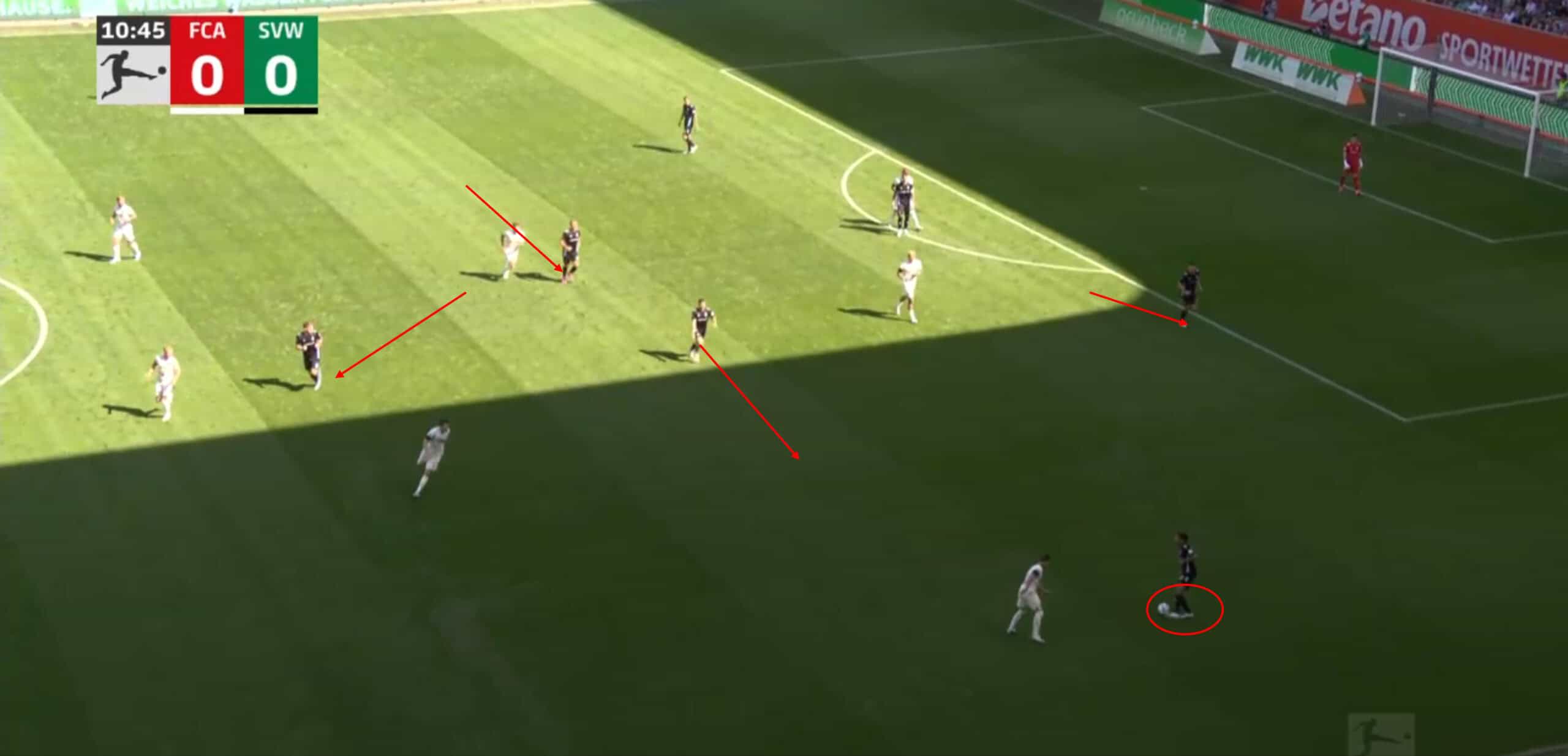
Here, we can see an example of this pattern of play in the first game of the season against FC Augsburg.
Werder builds up using a back-four, with right-back Agu dropping back to receive the ball and help his centre-backs in the passing game.
The near-sided midfielder Stage is moving forward, allowing Lynen and Schmid to make movements into the space to give Agu options for short passes, the same goes for LCB Milos Veljkovic.
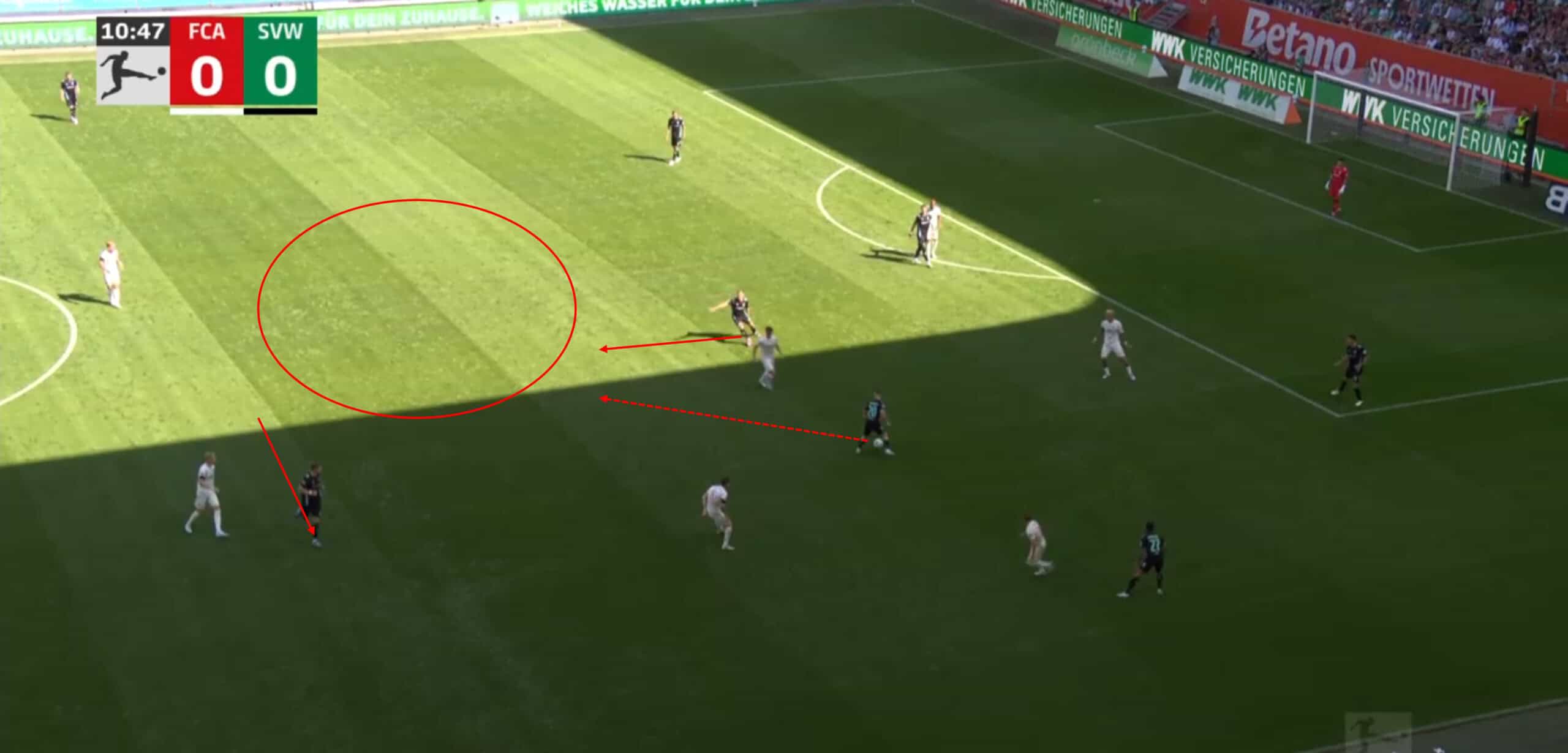
Werder is not actively looking for line-breaking passes at this stage but instead wants to get Augsburg to commit to the press.
Augsburg does so after Schmid receives the ball while facing his own goal, being crowded by four Augsburg players.
While Augsburg’s situation looks decent at first glance, this is precisely what Werder Bremen and Ole Werner want.
Romano Schmid is an excellent player between the lines. With his great agility, he is able to turn around quickly and find solutions, even in condensed spaces.
Here, Stage moves to the outside, which also drags Augsburg’s holding midfielder Breithaupt to the side.
With the other Augsburg midfielders only eying the ball because they want to get pressure onto Schmid, Senne Lynen can make a run in the vacated space behind Augsburg’s first line of pressure.
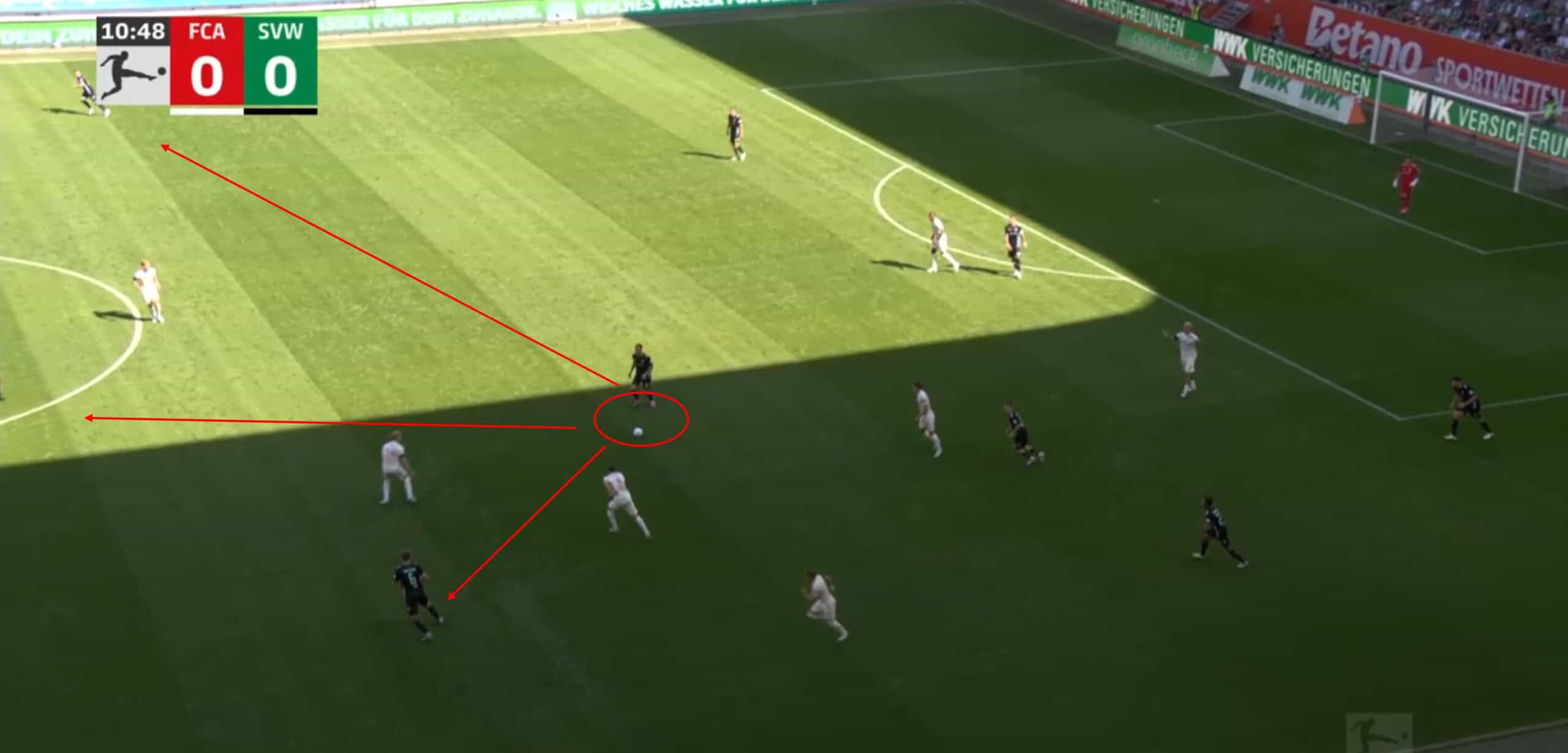
From there on, Lynen has multiple options to progress the ball, he still has Stage as an option in the short passing game, but he could also look to find depth instantly or he could play the switch to his right-back.
Werder looks to free up a man and get him the ball behind the first line of pressing, and he is able to do so in most of their situations.
Werder Bremen are also very secure with the ball in these situations, completing short passes at 88.7%.
In a press-oriented league, this can work wonders.
While it is hard for most teams to play against a deep block, and Werder Bremen is no exception to this rule, if you can get your opponent to move out of his shell, you will get space to exploit.
In the situations above, Werder already took out five Augsburg players, forcing them to defend with their faces towards the goal, which is very hard at the top level.
Obviously, this is not without risk, but Werder has another significant advantage: their goalkeeper, Michael Zetterer.
Zetterer joined the club in 2015, but it took him eight years and multiple loans to earn the starting spot between the posts for Werder.
Zetterer has done exceptionally well ever since he was appointed as Weder’s ‘number 1’, but he is not an exceptional goalkeeper in terms of his ability to stop shots.
What sets Zetterer apart from other players in his position is his ability with the ball on his feet.
He is highly accurate with long balls and is a valid option for Werder in the passing game.
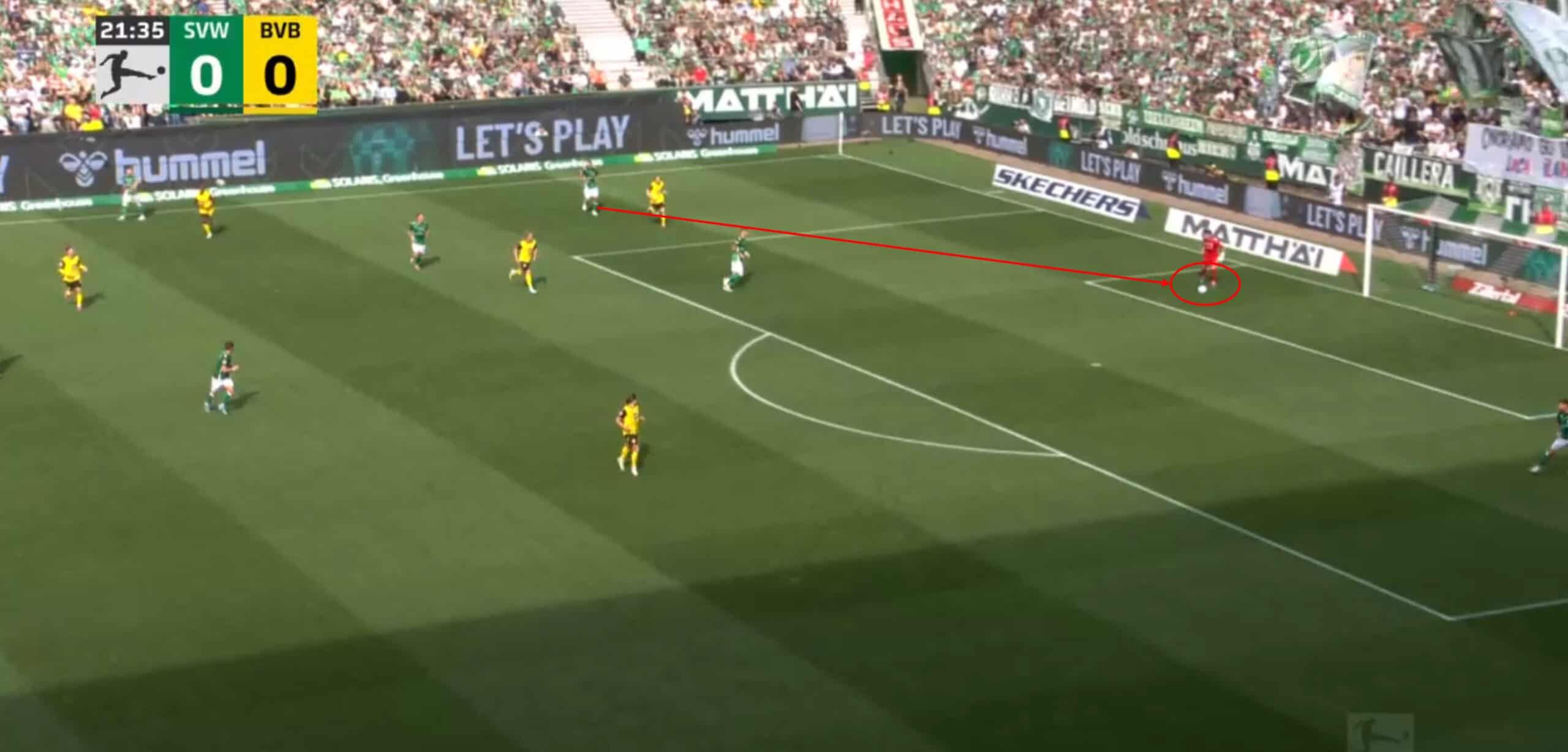
Here, we can see Werder getting pressed by Borussia Dortmund, finding no immediate solution.
Stark, therefore, simply plays the ball to his open goalkeeper, Zetterer, who is wide open and positioned to receive it.
Most goalkeepers would just punt the ball downfield here or instantly play it to the left centre-back to relieve the pressure, but Zetterer did neither of those things.
Remember, Werner wants his men to attract the press.
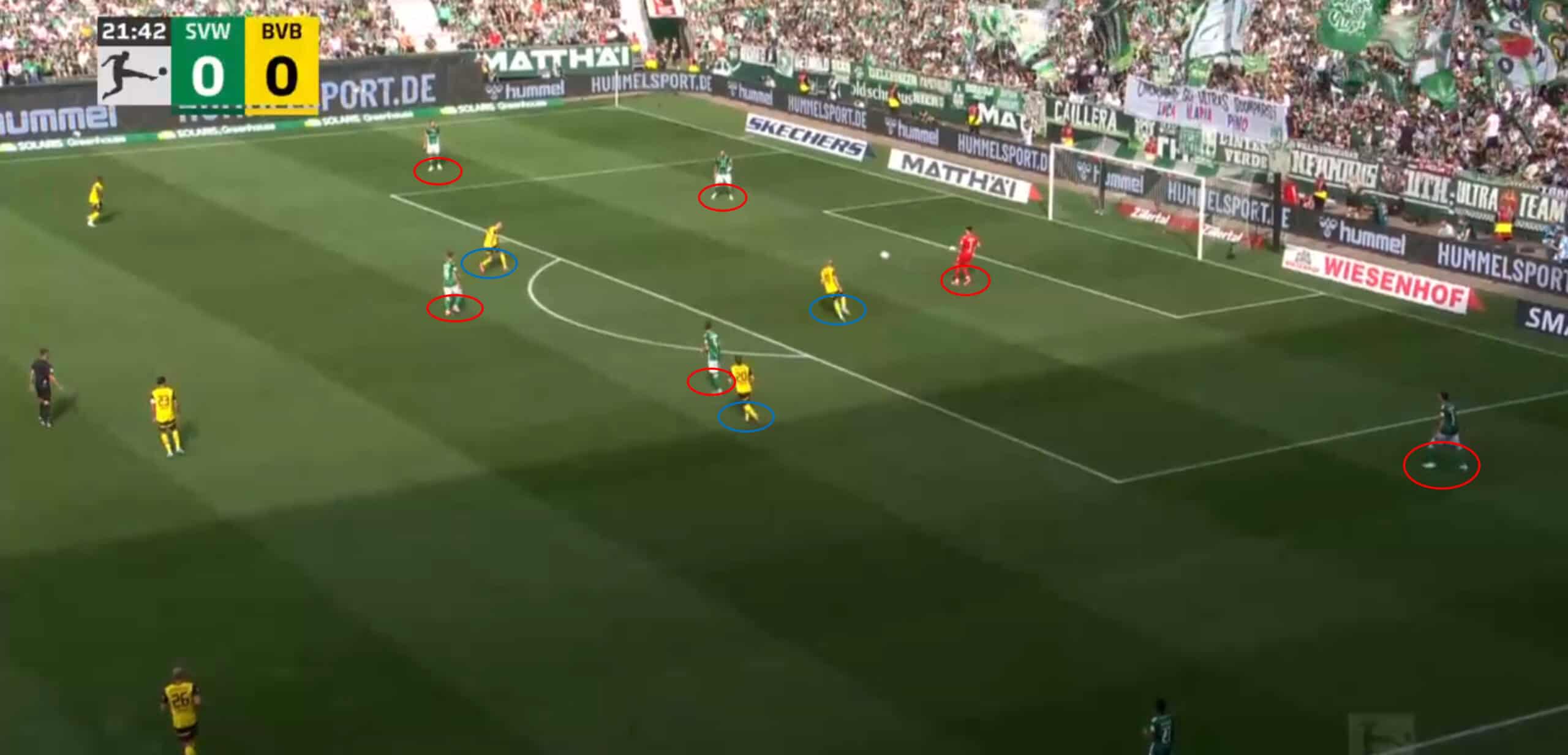
Therefore, Zetterer stays calm and keeps the ball on his feet for about five seconds, triggering the press of Dortmund.
Zetterer acts like an outfield player here, creating a back-four in the build-up with his three centre-backs.
With both midfielders of the double pivot dropping back as well, Werder now has a six-against-three situation in their own third.
This allows Werder to break the first line of Borussia Dortmund’s press, taking three players out of the equation already and freeing up Mitchell Weiser on their right side to progress the ball.
In a league that does not currently value possession play very highly, Ole Werner’s tactics at Werder Bremen are a breath of fresh air.
They exploit the weaknesses of the most common style of play in the Bundesliga.
Werder Bremen Defending
While conceding 11 goals in just five games in the Bundesliga so far this season does not scream „great defending“ at first glance, Werder has been a decent defensive team for quite some time now.
Unfortunately, conceding five goals against Vincent Kompany’s Bayern is just something that some teams need to accept.
Werder were a very aggressive team when they first got promoted back to the Bundesliga.
To start their comeback in the Bundesliga, they played with a very high line of attacking press and a very aggressive counter-press, but the team conceded way too many goals that way.
Ole Werner decided to tone back on that aspect of play last season, putting his team in a position where they needed to make fewer tough decisions and where they did not have to defend in a forward way as much.
This helped out his centre-backs and his holding midfielder a lot because there was less space to cover now.
Werder usually drops into their own half, only playing with a midfield press.
Marvin Ducksch triggers the press when the opposing team tries to cross the halfway line most of the time.
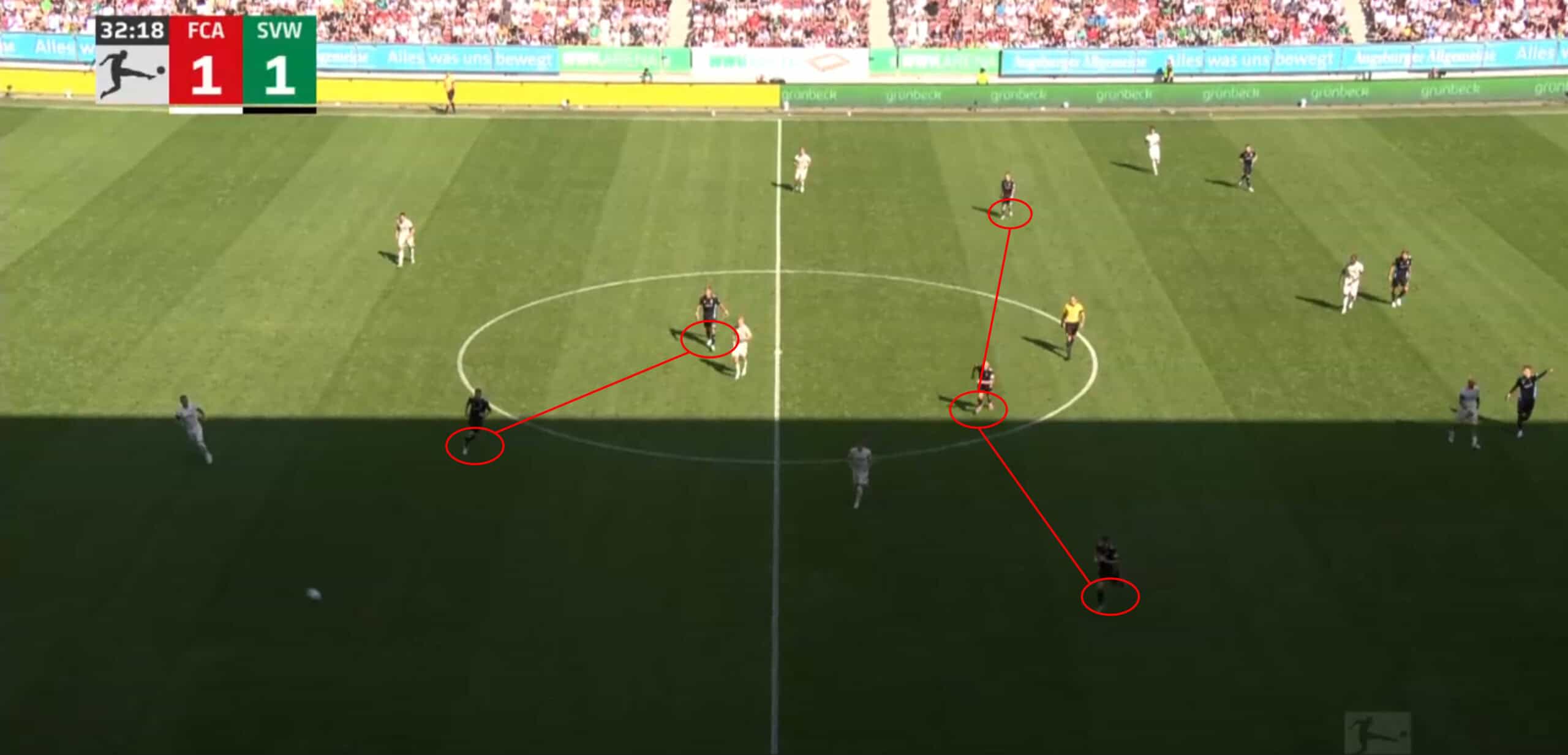
Werder usually returns to their old 3-5-2 formations, with the wingbacks dropping into the backline to form a back-five for the team.
While Werder struggled immensely with the depth of its defensive line last season, it is now in a much better position, pushing up the field and condensing its opponents’ effective playing space.
With their 5-3-2 shape, Werder fulfils one of the basic principles of football by prioritising the middle of the field over the wings, forcing their opponents to play the ball outside.
This also triggers the press for Werder.
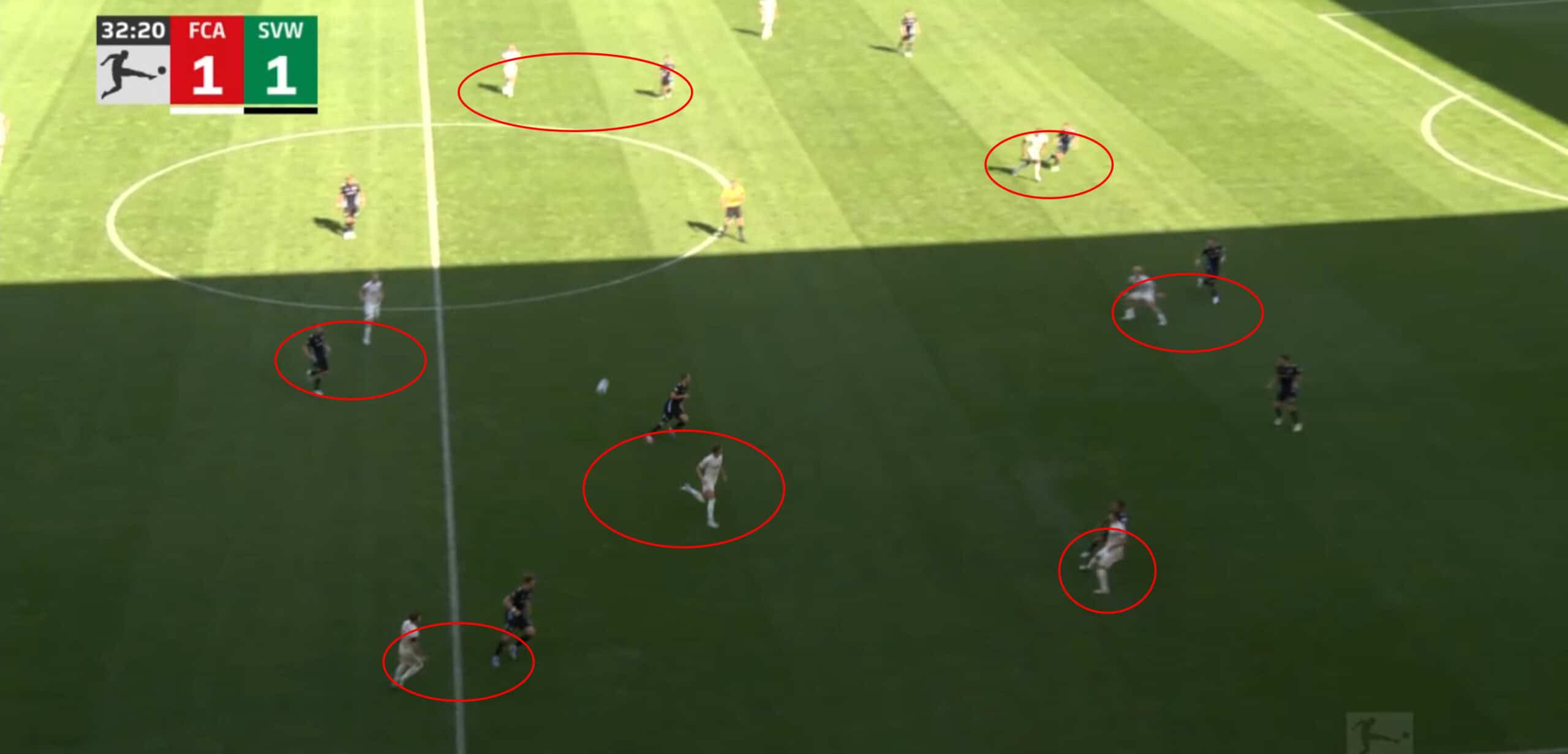
Ever since Ole Werner took over the team in the second division, Werder played with a very man-oriented press.
In the picture above, we can see just that.
After the ball is played outside, Werder’s midfield steps up, actively man-marking the Augsburg midfielders.
Even striker Marvin Ducksch drops back into midfield to mark the holding midfielder of Augsburg.
Two Werder centre-backs man-mark the two Augsburg strikers. One centre-back is freed up to cover the depth behind Felix Agu, who had to step up to mark another Augsburg player.
While this opens up space in the middle of the field right where the referee stands, Augsburg has no options to punish that.
They are forced to play a long ball into the middle of the field, but with both strikers closely guarded, they can’t play a lay-off here, and Werder wins the ball back quickly.
Another thing Werder does exceptionally well is defending in their own box.
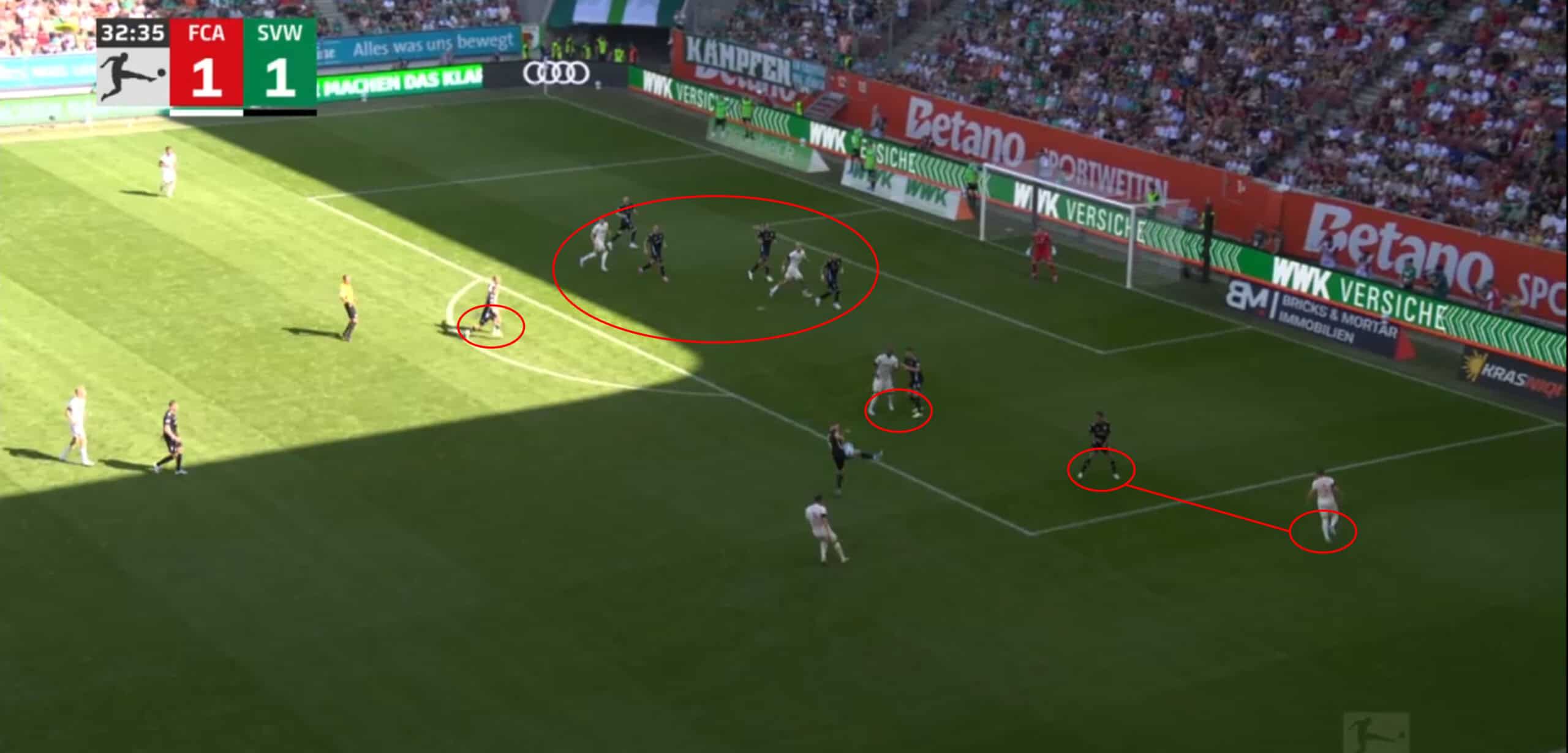
Here, we can see that Augsburg was able to play a cross from half space into Werder’s box.
Werner has his men drop back deep in these situations, focusing on defending the centre of the pitch.
The three centre-backs are covering the middle of the box, one on the near post, one on the far post and one in the middle of the box.
Holding midfielder Lynen and right-back Weiser are also dropping into the box, creating a 4vs2 situation at the far post.
The stage is covering the edge of the area, and left-back Agu is covering the Augsburg player out wide, allowing them to react to the second ball in a fraction of a second.
This allows Werder to be in control of the situation even while being forced back into their own box, and it is one of the things Werner has improved on with his men over the last couple of months.
Werder plays very intensely in these situations, and they always pull through 100% in every pattern, duel, and clearance, which allows Werder to defend very decently.
Werder Bremen Weaknesses
While it might have sounded like Werder is one of the top teams in the Bundesliga so far in this article, we will now take a look at where they still struggle and what is holding them back from tremendous success so far this season in the Bundesliga midfield.
Werder Bremen Transitional Play
While analysts try to break down the game into easy-to-understand phases and scenes, football remains a fluid game.
This means that every situation impacts the next situation, and so on.
So, while we are breaking down the team’s possession play in the build-up, transitional play, and attacking play, these phases are not cut off or isolated in any way; these phases of play influence each other at all times.
While Werder Bremen has been great at building up from the back so far this season, they struggle heavily in the transitional phase of play and often can’t really use their good build-up play.
This has a couple of reasons.
The first reason is relatively simple: Werder looks to free up players in the build-up and give them space to progress the ball.
This is great because it gives players the opportunity to make plays and puts them in a position to progress the attack further.
Still, Werder Bremen were promoted two years ago, and they currently do not have players in their squad who are exceptional in individual class or passing quality compared to the rest of the Bundesliga.
So, while they might create a lot of space for their players and put them in good positions, this is not useful if their players lack the quality to make the right decisions.
While Ole Werner is giving his team many options in the build-up, he prefers not to have any clear patterns of play in transition and the attacking phase and instead utilizes his players’ individual decision-making ability and the chaos they create that way.
That has not been going too great for Werder over the last couple of months, with players obviously being overwhelmed in crucial situations.
Another problem for Werder is the lack of depth in their play.
While it is excellent for the build-up if many players drop deep into their own half and create short passing options, you need to find a way to threaten the opposing goal at some point.
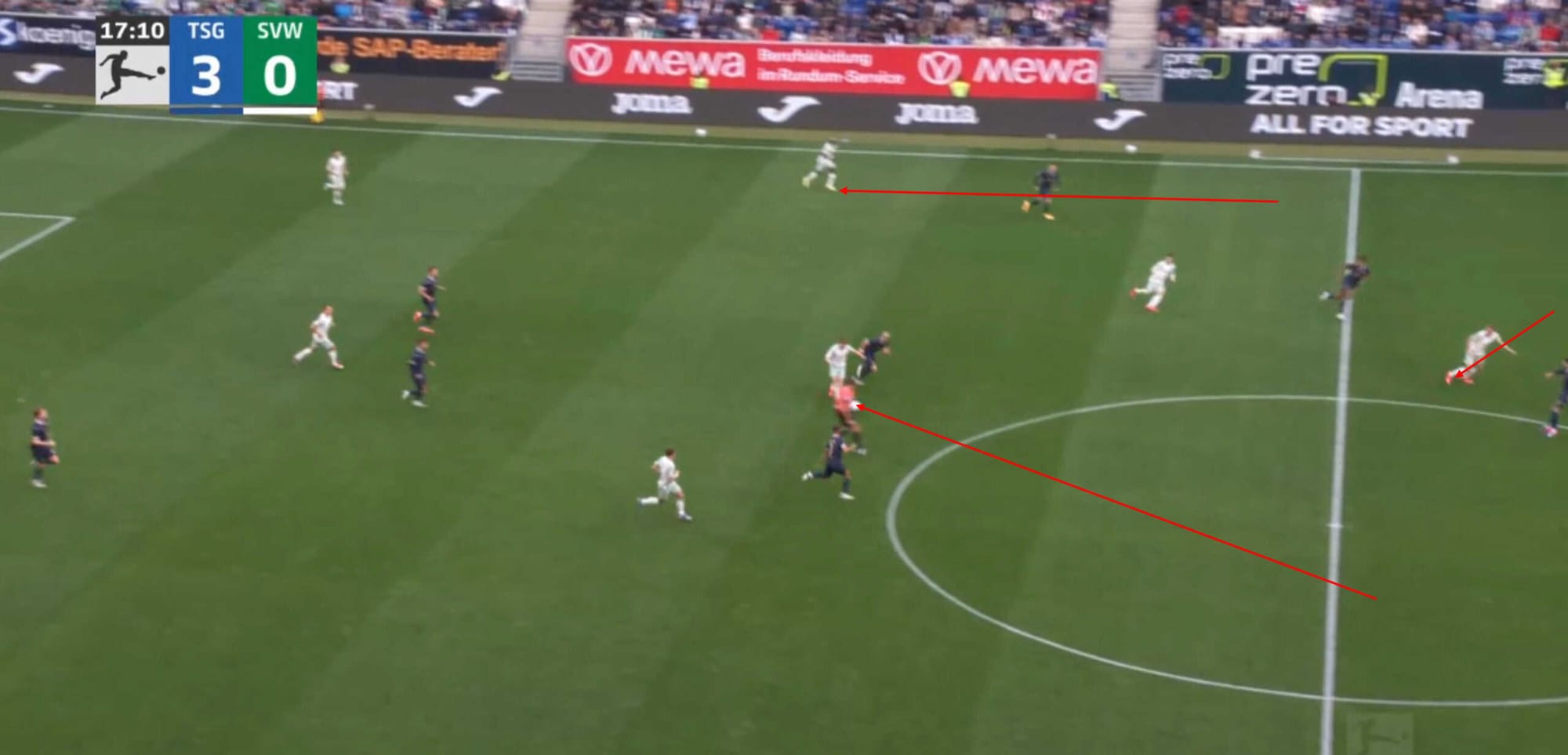
Here we have a situation for Werder in the game against Hoffenheim last week.
Hoffenheim played with a very aggressive press against Werder, putting them under a lot of pressure from the get-go.
This worked because when Werder dropped deep, Hoffenheim’s backline knew that there was no pressure on them.
Even striker Ducksch moved into his own half, so they could easily step up and force Werder into long balls.
In this situation, Werder was able to break the press once again by utilising Zetterer as an additional player in the build-up.
The goalkeeper also found the line-breaking pass for Mitchell Weiser, who dropped deep into the Werder half.
The problem here is, what does he do now?
His entire team is in their own half, striker Ducksch is no option because he is covered closely and also dropped back, as did Romano Schmid and Derrick Köhn.
There technically would be no real option to pick up the pace here, but Werder still uses a workaround to have some presence in the centre of attack and threaten the opposing defensive line.
Ole Werner is using his midfielder Stage and his full-back Agu as dummy strikers.
These two players constantly move into the attacker’s position when Ducksch once again drops deep.
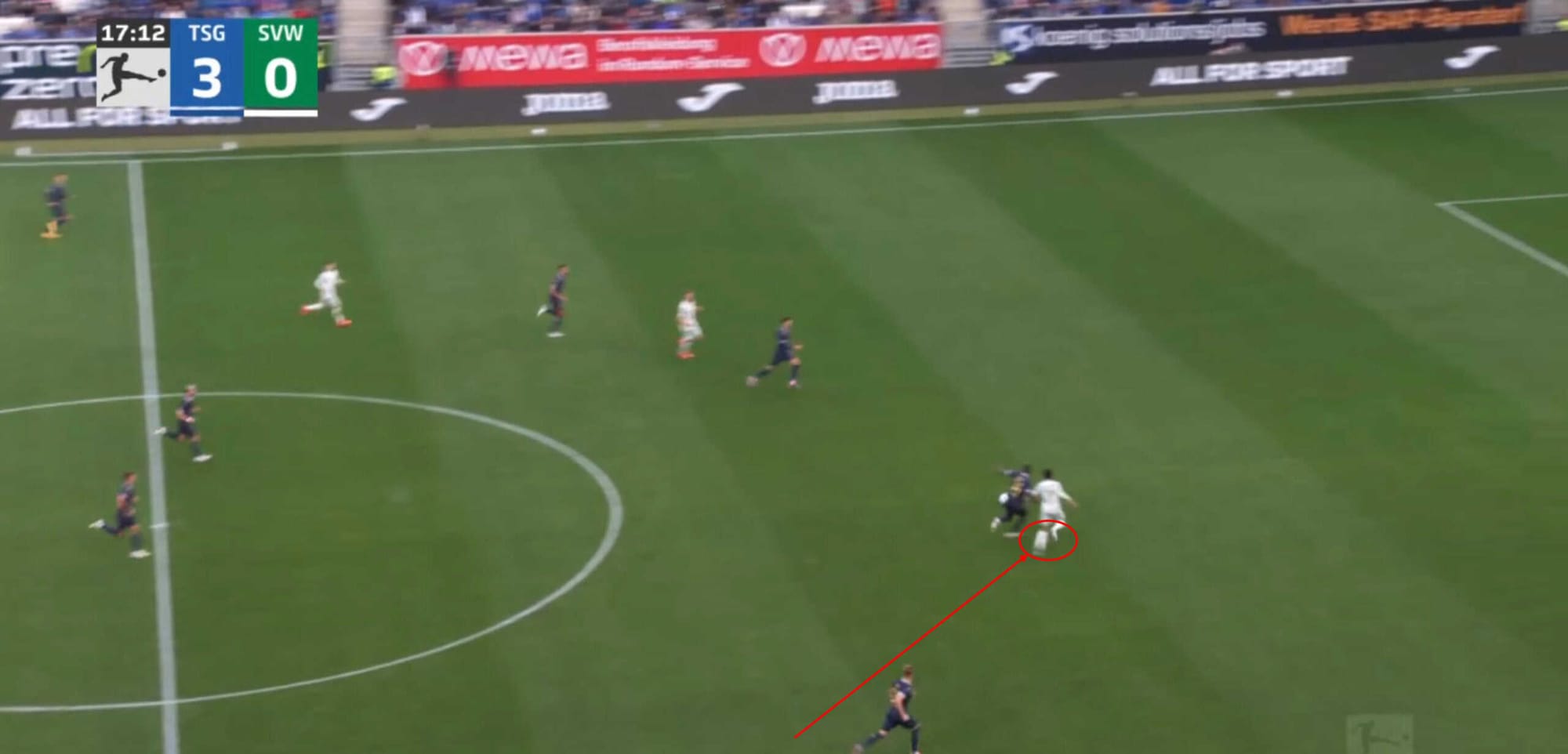
In this situation, Agu makes a great run behind Hoffenheim’s defensive line and times his run well.
Nsoki is caught entirely off-guard here because he thought the only attacking threats were outside his area.
He then fouls Agu and is sent off.
This situation decided the game last Sunday.
Agu would not have been able to do anything with the ball; however, he is not a goalscoring threat at all, and no other player would have been able to help him out here.
These struggles are holding back Werder Bremen’s attack, and with just 5.9 non-penalty xG created in the first five games of the season, Werder ranks 12th in the Bundesliga in that regard.
Even if they create good opportunities for Stage and Agu, neither of these players is very efficient in the final third, which further hinders Werder.
They need these two to make these runs, however, especially Stage, because otherwise, they would have no presence in the box.
It ended up working against Hoffenheim, with Stage scoring three goals against a decimated Hoffenheim and capping off Werder’s 4-3 comeback win.
Another player making these sorts of runs is Mitchell Weiser, who was put into the playmaking role by Werner against Hoffenheim after being a right-back for the rest of his time at Werder Bremen.
This creates other problems for Werder as well.
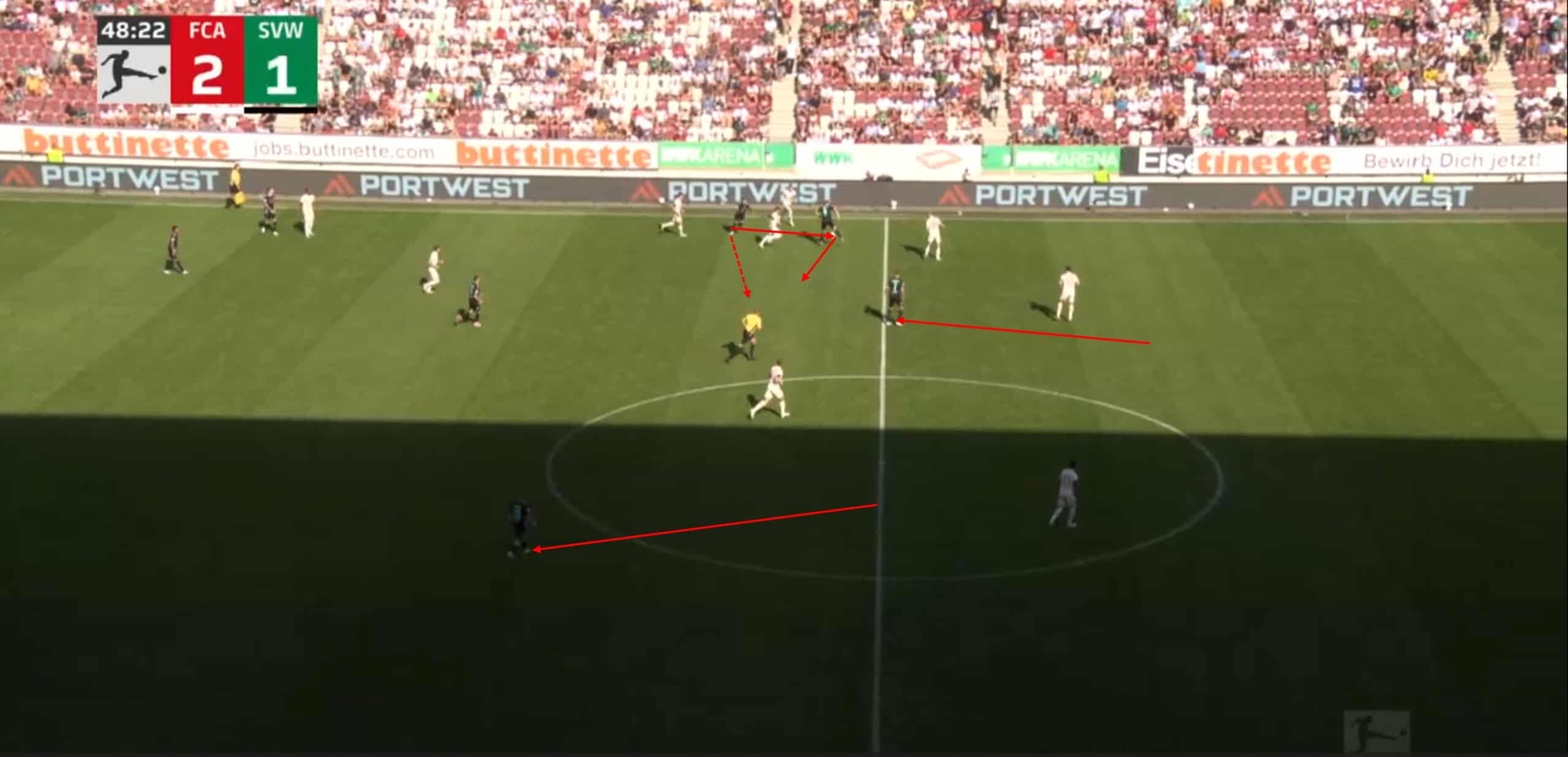
Here, we can see Werder once again dropping back into their half with all 10 outfield players.
On the left side of the field, Agu and Stage are playing a quick one-two, breaking Augsburg’s press with just two passes.
The problem is that even after Agu receives the ball in space, he lacks the quality on the ball to actually transition the attack quickly.
With all attackers dropping deep, there are no real options for picking up the pace and threatening the space behind the defensive line.
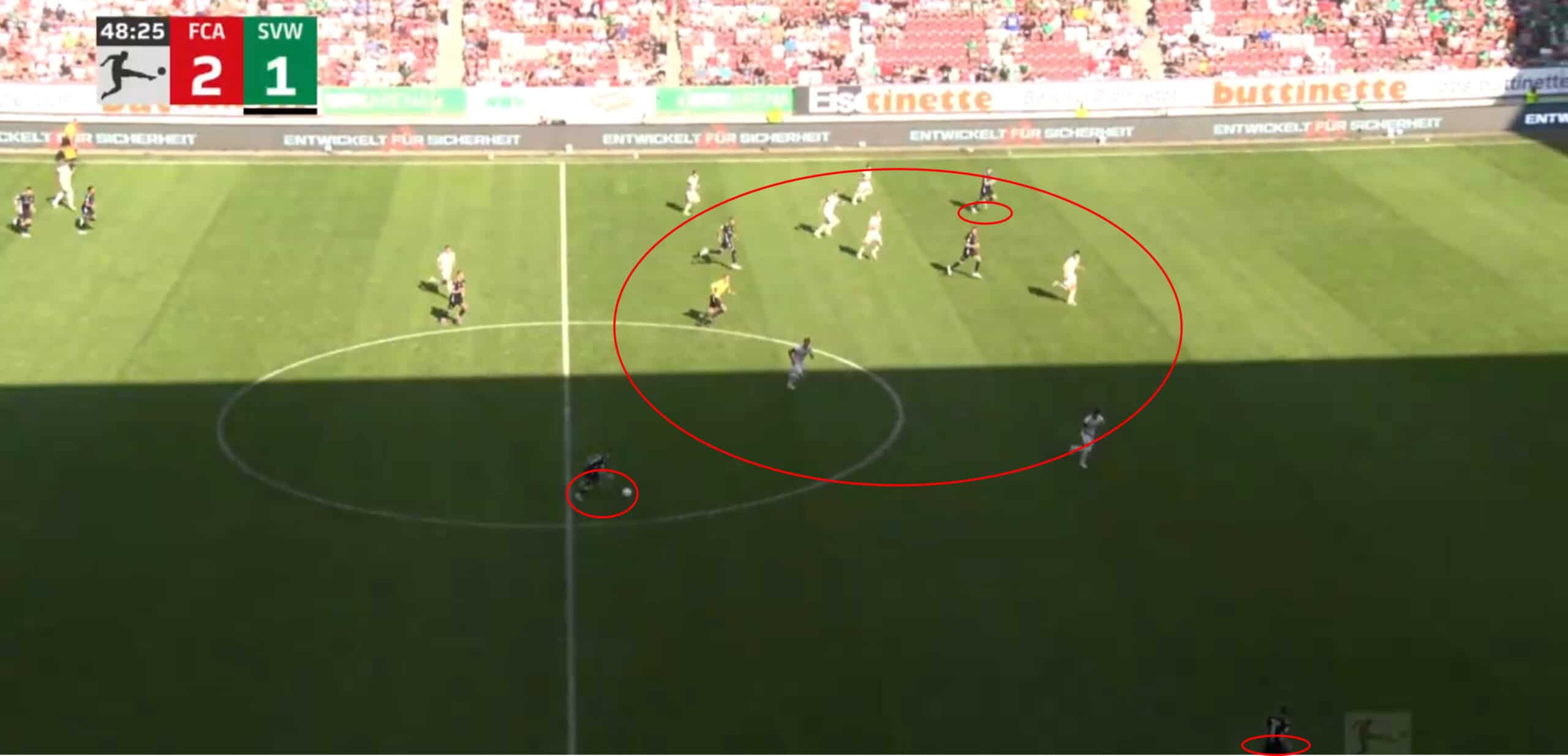
Agu play a pass to Romano Schmid, who then finds himself in a lot of space but also has a lot of distance to cover between himself and the goal.
This is another problem for Werder: when you attract the press near your own box, you need to somehow cover the distance of the entire pitch to score yourself, which is not as easy as it might seem.
With Njinmah running around in midfield and Ducksch being covered, Augsburg has a 7v3 situation on the far side of the field.
Ducksch isn’t even making a run, really.
The play that is the nearest to Augsburg’s baseline is once again Jens Stage.
Felix Agu was needed in the build-up but cannot make a run forward here because his stamina is also limited, forcing Werder to play the ball out wide again.
While Weiser makes a good run and receives the ball in space, he is still forced to play an early cross.
With only Stage and Ducksch in the box against five Augsburg defenders, the attack once again proved ineffective.
Werder simply lacks presence in the attacking centre.
He cannot have a target man in the middle or have someone threaten the depth of the field, so Werder struggles immensely in transitional play.
Easy Losses
While Werner’s workaround with Agu and Stage somehow establishes a presence in the box and threatens the space behind the opposing defensive line, it also comes with downsides.
As established previously, without a threat to push the backline back, Hoffenheim was able to put a lot of pressure on Werder in the build-up last week, which forced many bad passes and long balls for Werder.
While Marvin Ducksch is a very interesting type of striker and has many unique strengths, his presence up front is a huge weakness in his game.
He doesn’t take on aerial duels and is bad with his back towards goal in long-ball situations, which makes him a horrible target man.
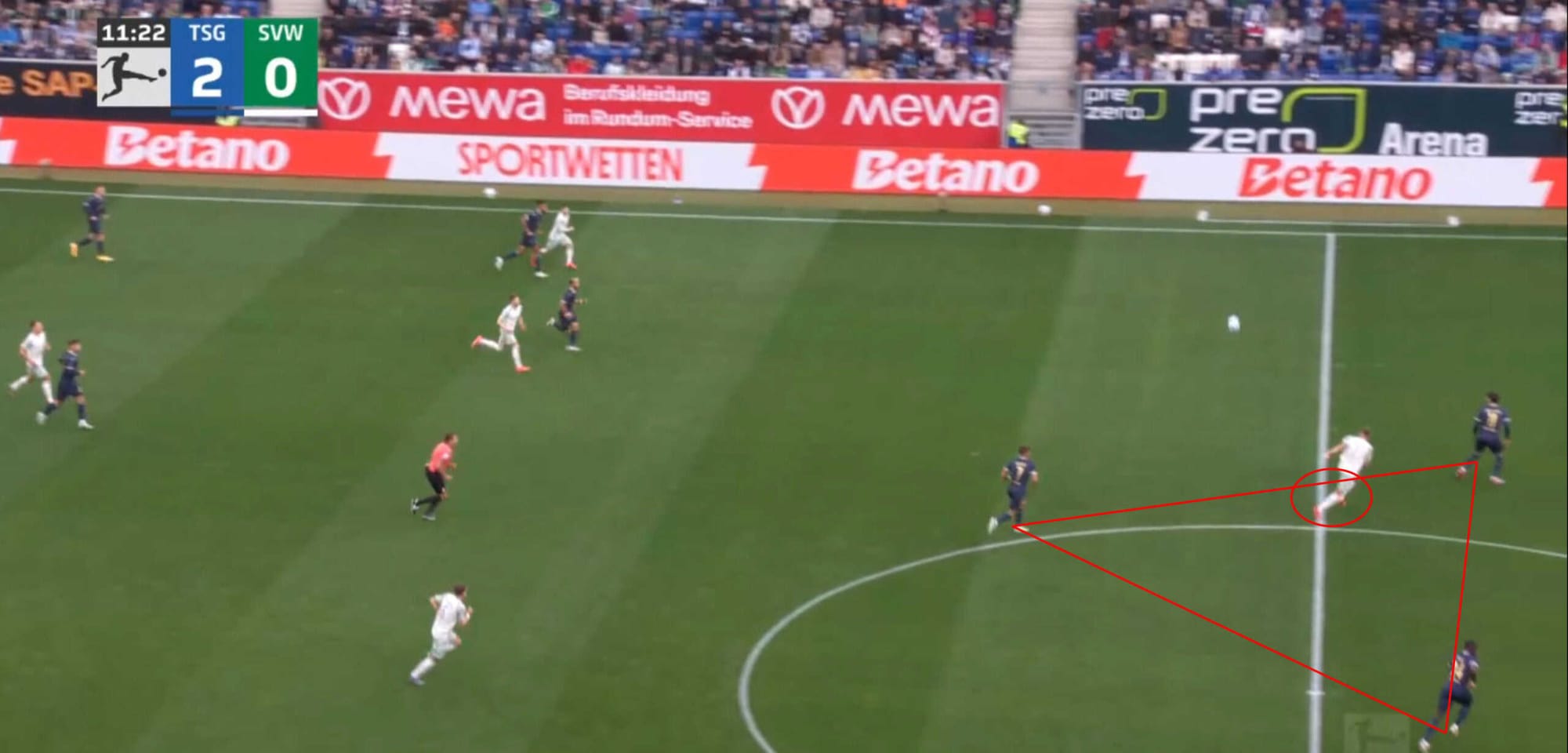
Here, we can see that Hoffenheim was once again successfully pressing Werder’s build-up and forcing a long ball.
With only Ducksch forward and the rest of the team dropping back, Hoffenheim was able to press forward even with their defender.
Werder players have been dispossessed 51 times this season so far, ranking second to last in that regard in the Bundesliga.
Anthony Jung, therefore, had no other option than trying to find Ducksch with a long ball.
Three Hoffenheim defenders closely guarded the striker, and since he is not a good player in these situations anyway, Hoffenheim was able to win back these balls easily and suffocate Werder in their own half.
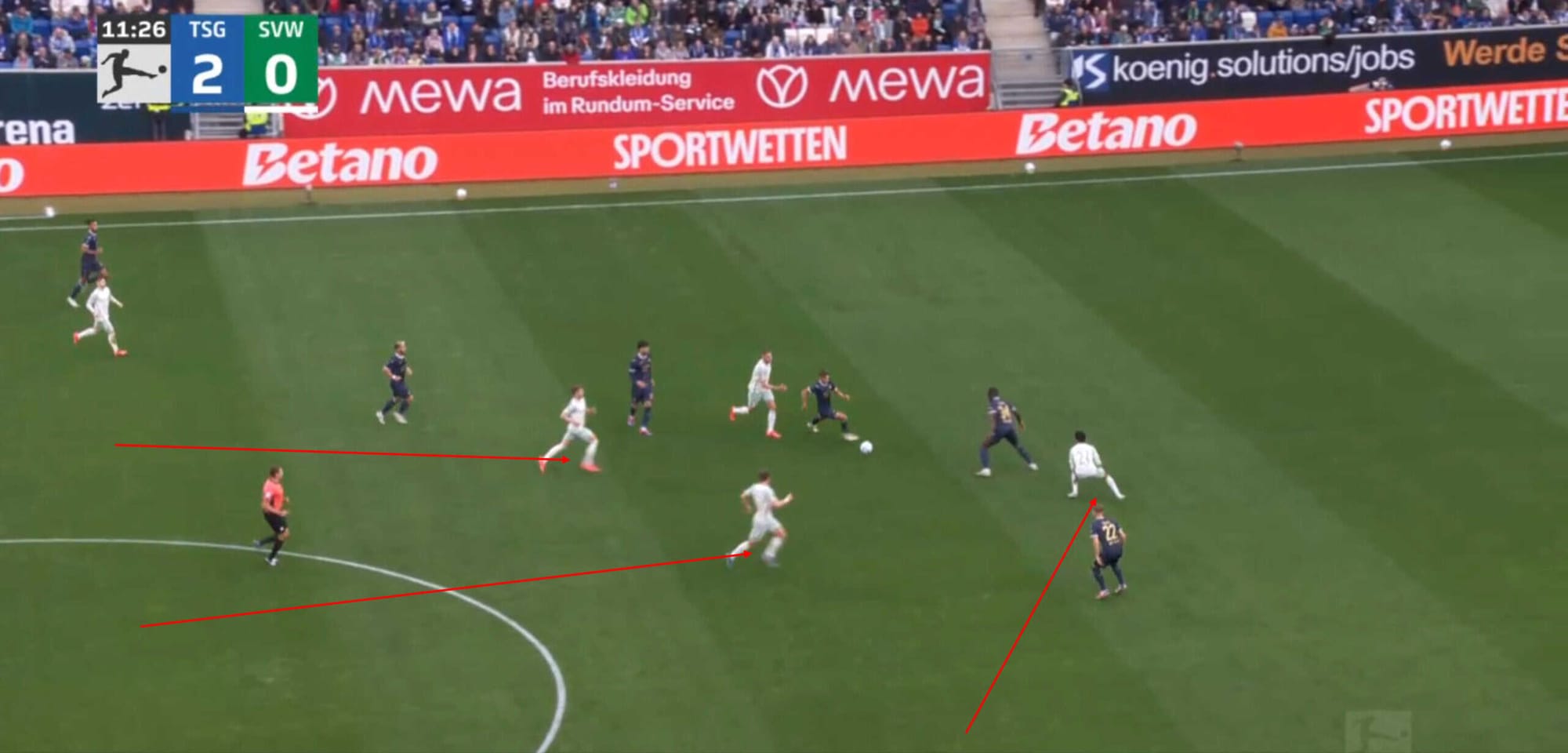
As the situation continued, the Hoffenheim defenders were not able to establish control of the ball instantly, which led to Werder attacking.
Once again, to establish a presence in the attacking centre, Jens Stage, Felix Agu, and Mitchell Weiser ran forward to help Marvin Ducksch in the counter-press situation.
However, Hoffenheim still had the numbers advantage and completely cut through the press with ease.
This left Werder vulnerable, and Hoffenheim was able to attack the right defensive side of Werder, forcing Malatini and Lynen into bad situations and ultimately scoring the third goal in just 12 minutes.
Bayern played in a very similar way against Werder, who suffocated in their own half and still had to give up their defensive stability to try to find some relief from the press.
Against Bayern, Werder folded and got smacked 5-0, against Hoffenheim it looked even worse for 17 minutes until Nsoki got sent off and saved the game for Werder.
Conclusion
If we count only games played in 2024, Werder Bremen ranks seventh in the Bundesliga, with 34 points collected in 23 games.
The team’s good form continued from last season and they have found success to start off this season as well, even though they had to play against Bayern Munich and Borussia Dortmund in their first four fixtures.
Ole Werner has his team playing some inspiring football, standing out in a league that focuses on the work against the ball rather than trying to find solutions in possession.
Especially in the build-up, Werder Bremen is one of the best teams in the league. It shows calmness and composure while attracting the press and constantly finding solutions to free up its players in open space behind the first line of press.
Werder struggles with transitioning their attacks, however.
Ole Werner has his team commit a lot of manpower to the buildup, which means his players have to cover a lot of distance to even start an attack.
With no authentic patterns of play, his players sometimes look overwhelmed in decision-making while attacking.
Werder has showcased a lot of potential in these situations as well but now needs to find a way to string together a more coherent way of attacking.
With their problems in attacking, Ole Werner has found some workarounds to help his team, but these have their own downsides.
Werder has suffocated themselves at times and lacks an attacking threat and presence in the centre of attack, which is another problem for the team.
Overall, Werder still looks like one of the better midfield teams in the Bundesliga this season.
This is an impressive development since Ole Werder took over the team in the second division.
They still need to make some progress to make a run and return to European football in 2025; otherwise, the former giant will be in for another season in the midst of nowhere.

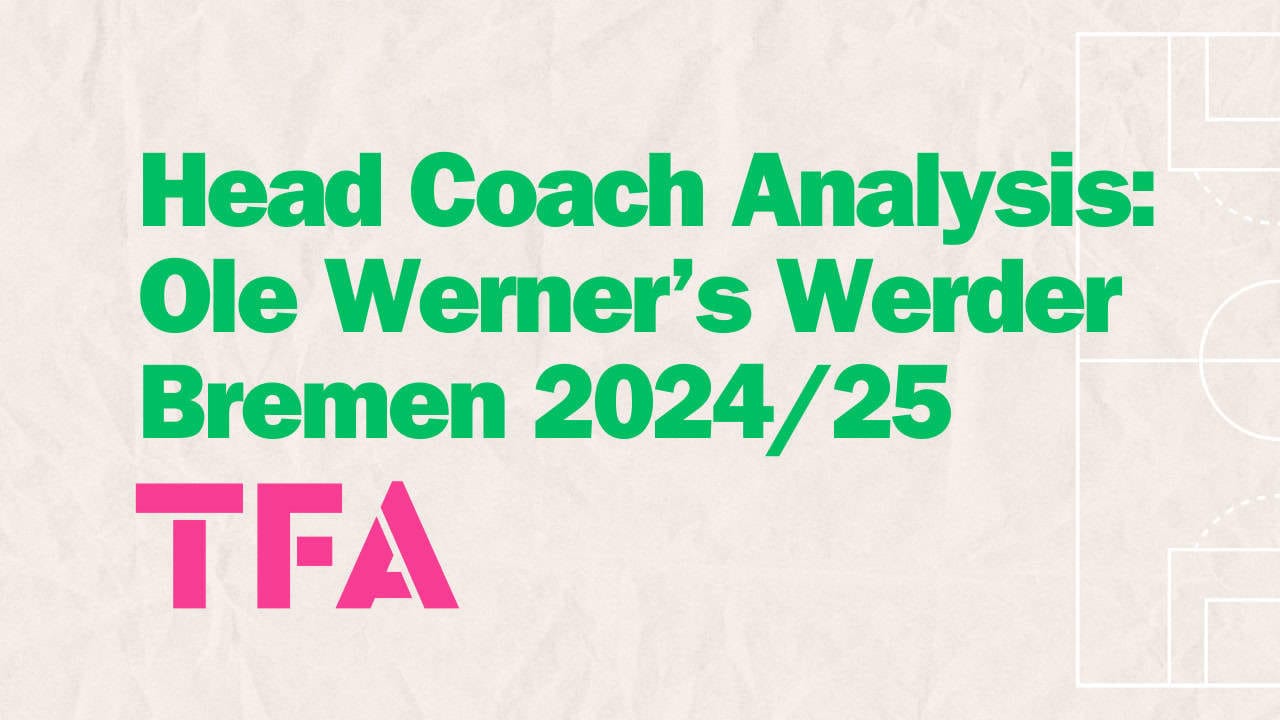




Comments